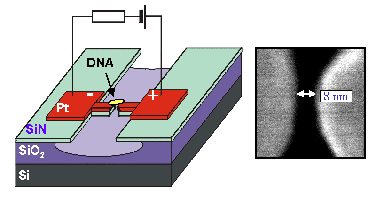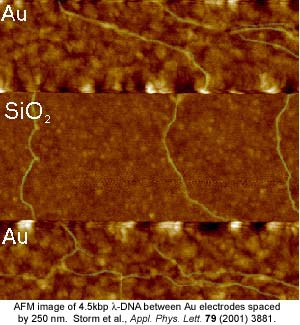Insulating electrical properties of DNA
Is DNA a conductor for electrical charges? This question has been heavily debated over the past few years, spurred by optical experiments that measured fluorescence quenching for DNA molecules. Fink and Schonenberger reported a first electrical measurement on that suggested that DNA is a good linear conductor. Kasumov et al additionally found low-Ohmic behaviour for DNA in the dry state. These experiments motivated us to explore the electrical properties of DNA molecules.

Conductance measurements on short DNA oligomers
We have obtained measurements of electrical transport through well-defined short DNA molecules that show, by contrast, no finite conductance at low bias. Instead, a large gap (~1V) was observed.
Ten nm long, double-stranded poly(G)-poly(C) DNA molecules were connected to two metal nano electrodes that are separated by 8 nm by electrostatic trapping. Non linear current-voltage curves were observed at ambient conditions as well as in vacuum and at cryogenic temperatures.. Typically, a gap of a few volts was observed.
Sample to sample variation appeared to be large. The poor quantitative reproducibility of these single-molecule experiments did not allow to test features such as sequence dependence quantitatively with this technique.
Conductance measurements on longer DNA fragments
Subsequently, we developed planar electrode structures that allowed scanning probe microscopy on the (somewhat longer) DNA between the contacts. Fragments of lambda DNA with a length of 1.5 micron (4500 base pairs) were deposited on gold electrodes spaced by about 250 nm. By AFM imaging single DNA molecules were found between the electrodes. The measured resistance between the electrodes was found to be larger than 10 TOhm per molecule. Below is an AFM image of DNA over gold electrodes.
It is concluded that DNA is insulating. This conclusion was further confirmed by an extensive set of experiments with variation of key parameters such as base-pair sequence [mixed sequence and homogeneous poly(dG)·poly(dC)], length between contacts (40 nm to 500 nm), substrate (SiO2 and mica) and electrode material (gold and platinum).
Conclusion on DNA conduction properties
In large electric fields, electron transfer appears to be possible at the scale of a few nm
On the 40 nm scale, however, all our transport experiments show the absence of any conduction (Resistance > 10 TOhm / DNA molecule)
DNA in the dry state is not a well-conducting molecular wire but in fact DNA is an excellent insulator
